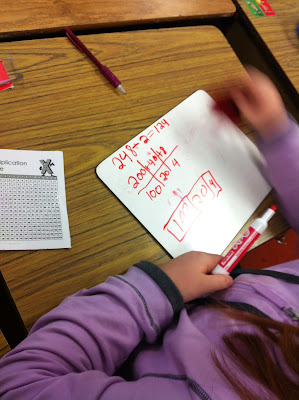We began by using base-ten blocks. We are pretty good at using them after using them for modeling decimals as well as multiplication. They knew that if they didn't have enough flats (100's) to fill in the groups evenly, they would have to break one into ten 10's and go from there. I was extremely happy that they were so fluent in this from adding and subtracting decimals! They had no idea they could divide this way. I chose some of my struggling students to model this in front of the class. They were extremely successful and were proud to show the class even they could divide large numbers. Here are some pics of Sam and Bobby dividing using models:
 |
| Sam had to break a long into 10 ones! He did a great job! |
Next, we moved on to using the distributive property and expanded notation to divide. The kids are pretty proficient in writing numbers in expanded notation, so we really just had to take it a step further to create the area model. Here is Allison using her whiteboard to solve. You can see she broke 248 into 200+40+8, then divided each part by two, and finally added her quotients. Her area model is below, except I caught her before she had completed it, but you get the idea!
Below: Max bypassed drawing the model and opted instead to just divide each part by three. Then, he added up the quotients.
Lastly, we learned the partial quotients method for division. Personally, this is my favorite. It allows kids who aren't as proficient in their math facts to still be successful in division. It also really shows the value of the numbers, something my students clearly struggle with. Here is a shot of Keegan flying through a problem with ease. I think he's found his favorite way to divide!
Today, after a long, warm weekend of fun, we spent some time going back over each method for division. I split the kids up into partners: a student who "gets it" with a student who doesn't. They really worked well together and as I circulated I heard the helpers saying things like "how many times does 3 go into 400-some? Does it go in at least 10 times? Do you think we can go higher?" Sometimes, all it takes is some guidance from a peer rather than teacher lady. I'm OK with that!
Lastly, we created anchor charts showing the ways for division. We added a fourth way, the traditional way. I found that my "high" kids like the traditional way, and I'll let them use it as long as they can explain each step using place value! (Muahahahaha!) Don't forget to check out our division math rap on YouTube!
Common Core Connection: Standard: Find whole-number quotients of whole numbers with up to four-digit dividends and two-digit divisors, using strategies based on place value, the properties of operations, and/or the relationship between multiplication and division. Illustrate and explain the calculation by using equations, rectangular arrays, and/or area models.
Mathematical Practices: Make sense of problems and persevere in solving them.






No comments:
Post a Comment